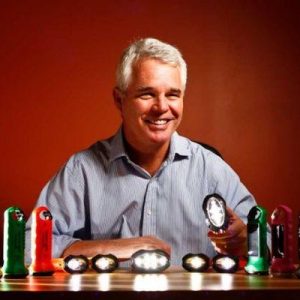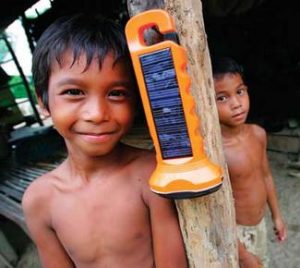Helping Those In Need In Foreign Countries
 Let’s talk about a great man and his efforts to help those in need.
Let’s talk about a great man and his efforts to help those in need.
The New York Times has published an article about Mark Bent’s BoGo program. It covered his efforts and then his work and approach that was subsequently singled out on the NY Times editorial pages in an article entitled “Lighting the Way”. There have also been articles in Readers Digest, Newsweek, Metropolitan Home, the Dallas Morning News, the Times of India and a number of other internationally distributed media outlets and non-US countries. Fox News ran a segment about the BoGo program, Living on Earth, heard on National Public Radio has done a story, the Voice of America has published an article and distributed a video, Mark has been interviewed by BBC radio, the Pacifica Radio Network and has been heard on a number of other radio stations around the US.
The company is headquartered in Houston and is registered as a limited liability corporation in the State of Texas. We have international distributors in a number of countries – Kenya, Tanzania and Ethiopia at present and are set to expand our commercial network in the very near future. Our partners and customers include the United Nations High Commission for Refugees, (UNHCR), the United Nations, the Millennium Challenge Corporation, the United Nations Children’s Fund (UNICEF), the International Finance Corporation of the World Bank group, the US Department of State, the US Department of Defense, the US Agency for International Development, the ExxonMobil Corporation, Chevron, Schlumberger, African Wildlife Foundation, Samaritan�s Purse, Direct Relief International, Africa Inland Missions, Engineers Without Borders, World Vision, Global Giving and many other leading companies, Universities and non-profit corporations. Additionally, the Rockefeller Foundation has supplied grant funding, NASA, via the Space Alliance Technology Outreach Program has provided no cost engineering support, Rensselear Polytechnic is the only university in the US to offer a Masters degree in Lighting provided additional technical support and detailed product review, Columbia University, via the work of Jeffery Sachs and the UN Millennium Project have conducted extensive field studies of our products, Department of Energy senior scientists and engineers from Lawrence Livermore Laboratories at the California at Berkeley, via the Lumina Project, a World Bank Lighting Africa financed effort, have also conducted extensive field tests of our products.
 Forward plans include a total redesigned solar flashlight, with upgraded function and capability, due out in the first quarter of 2008. The new light has upgraded micro-electronic s and micro-processing power management systems, better integrating the flow of power between the solar photovoltaic panel, the long lasting rechargeable batteries and the light emitting diodes – LEDs, which provide illumination for up to 100,000 hours of use. The new electronics will also include a ‘power voltage booster module’ which will result in a decrease in battery charging time requirements on cloudy days to achieve a full charge and greatly extend the working life of the LEDs and batteries. The level of illumination provided by the LEDs has been enhanced and the average use time prior to requiring recharging has been greatly extended by the combination of all of these upgrades. The new model will also have redesigned optics and a new LED selection option, for the first time in any solar flashlight anywhere providing the user the ability to switch from directed task lighting for reading and other high light focused work, to a room illumination light – with only the press of a button. We have also redesigned the primary casing of the flashlight, to allow for much stronger resistance to the entry of water, dust and other containments – we will now have one piece of molded casing where before we had two; allowing us to now avoid the use of gaskets and screws for this aspect of assembly. In another unique development, the batteries on the new light will be inserted individually into their own single-battery water-tight compartments, with each of these compartments then being further isolated and suspended via honeycombed links. This SunNight Solar innovation will allow for air-cooled batteries, which will add to their efficiency and extend their operational life span, especially in hot climates.
Forward plans include a total redesigned solar flashlight, with upgraded function and capability, due out in the first quarter of 2008. The new light has upgraded micro-electronic s and micro-processing power management systems, better integrating the flow of power between the solar photovoltaic panel, the long lasting rechargeable batteries and the light emitting diodes – LEDs, which provide illumination for up to 100,000 hours of use. The new electronics will also include a ‘power voltage booster module’ which will result in a decrease in battery charging time requirements on cloudy days to achieve a full charge and greatly extend the working life of the LEDs and batteries. The level of illumination provided by the LEDs has been enhanced and the average use time prior to requiring recharging has been greatly extended by the combination of all of these upgrades. The new model will also have redesigned optics and a new LED selection option, for the first time in any solar flashlight anywhere providing the user the ability to switch from directed task lighting for reading and other high light focused work, to a room illumination light – with only the press of a button. We have also redesigned the primary casing of the flashlight, to allow for much stronger resistance to the entry of water, dust and other containments – we will now have one piece of molded casing where before we had two; allowing us to now avoid the use of gaskets and screws for this aspect of assembly. In another unique development, the batteries on the new light will be inserted individually into their own single-battery water-tight compartments, with each of these compartments then being further isolated and suspended via honeycombed links. This SunNight Solar innovation will allow for air-cooled batteries, which will add to their efficiency and extend their operational life span, especially in hot climates.
We also have a number of other new products under development – a fixed place solar powered room illumination system consisting of a two watt solar panel, a rechargeable battery pack and four LED light bulbs, two versions of solar powered LED lanterns, a solar powered mobile phone charger, solar powered UV water treatment units and with the support of the Rockefeller Foundation, we are exploring the design and engineering of a device which negatively impacts the mosquitoes which carry malaria – either we kill them, repel them or make them sterile.
Our firm’s mission statement is “We design and manufacture solar powered products which have a positive impact on people and the planet”. We thank you very much for your patronage and support.
The Importance Of Light
Why does light matter?
Two billion people living in the developing world rely on kerosene lanterns, candles, and single-use battery flashlights for light at night. Not only are these options expensive, dangerous, and harmful to the environment, they also negatively impact health, education, and security. Literacy and Education Our lights provide an opportunity for children to read at night and to extend school hours. This is especially important in developing countries where most children spend all day tending crops, taking care of livestock, or working in cottage industries. Kerosene is increasingly expensive, especially given the recent rise in the price of petrochemicals, so many families cannot afford it. Flashlights are even more expensive, and candles do not provide adequate lighting to read. As a result, many children will never learn to read and will be trapped in a life of poverty. Our lights give them a chance at a better life, thus education is one of the strongest pillars in our vision to light the world.
The BoGo Light
 The BoGo Light is a scientific, eco-friendly breakthrough that is making an impact worldwide. From Cairo to Cape Town, from the Caribbean to the Amazon, it is improving the lives of individuals, families, and entire villages by replacing costly kerosene, candles, and disposable battery flashlights with an affordable, long lasting, solar flashlight. BoGo means Buy one, Give one. We want our lights to benefit the less fortunate; therefore, with each light purchased in the developed world, a second identical light will be donated to an organization that will distribute it in the developing world with our direct financial support. Give the Gift of Light, and Help Us Change the World!
The BoGo Light is a scientific, eco-friendly breakthrough that is making an impact worldwide. From Cairo to Cape Town, from the Caribbean to the Amazon, it is improving the lives of individuals, families, and entire villages by replacing costly kerosene, candles, and disposable battery flashlights with an affordable, long lasting, solar flashlight. BoGo means Buy one, Give one. We want our lights to benefit the less fortunate; therefore, with each light purchased in the developed world, a second identical light will be donated to an organization that will distribute it in the developing world with our direct financial support. Give the Gift of Light, and Help Us Change the World!
Environmental Impacts Global Warming
Our lights help reduce the emission of greenhouse gases. Dr. Evan Mills of the US Department of Energy states that a single kerosene lantern, used four hours a day, emits over 100 kg of the greenhouse gas, carbon dioxide, into the atmosphere each year. As a comparison, the US Environmental Protection Agency (EPA) calculated that a passenger vehicle emits on average 11,450 pounds of carbon dioxide into the atmosphere each year. Therefore, replacing approximately 52 kerosene lanterns in the developing world with solar powered lights is equivalent to removing one vehicle from the roads here in the US.
Battery Groundwater Contamination
The EPA notes that “The single largest source of mercury in garbage is household batteries, especially alkaline and button batteries. Mercury is a heavy metal with high toxicity. Long-term exposure can permanently damage the brain, kidneys, and fetuses. The major way people get exposed to mercury is by eating mercury-contaminated food, especially fish.” After kerosene and candles, the most prevalent source of lighting in the developing world is conventional flashlights. According to its web-site, the Energizer Corporation, manufactures six billion batteries annually. Consider the environmental and damage to humans when even a fraction of these batteries are sold in developing nations and improperly disposed of. We are committed to addressing this problem. Our products are powered by rechargeable batteries, which only need to be replaced every two to three years, and we are also working on a buy-back/exchange program.
Deforestation and Top Soil Erosion
The actual rate of deforestation for lighting is difficult to quantify due to the lack of specific reporting data. Anecdotal reporting and common sense indicate that wood fires in developing countries are kept going long after the meal preparation to provide residual lighting. The loss of underbrush contributes to top soil erosion, which negatively impacts farmers. We intend to alleviate these two problems by reducing the consumption of wood for lighting purposes.
Health and Safety Cancer
According to the World Bank, 1.6 million people die each year from indoor air pollution associated with the burning of wood, dung, agricultural residues, and coal. That is one person every twenty seconds. The World Bank also notes that 780 million people in the developing world, mostly women and children, are exposed to kerosene lantern fumes equivalent to two packs of cigarettes a day. More than two-thirds of lung cancer victims in the developing world are female, as women are the primary homemakers. Help us change these alarming statistics by giving them the gift of clean, solar light!
Accidental Fires
Hundreds of thousands of people are injured or killed each year and their homes destroyed by accidental fires caused by the widespread use of kerosene lanterns. Help us reduce these preventable tragedies by replacing their kerosene lanterns with safe, solar light.
Malaria
Mosquitoes are attracted to kerosene light, but they are not naturally attracted to light given off by white light emitting diodes (LEDs). The reason for this is that mosquitoes have receptors which detect carbon dioxide, and kerosene lanterns emit volumes of carbon dioxide whereas LEDs do not. This suggests that people using our LED powered lights may lower their risk of contracting malaria. This is an exciting idea, and we have contacted the Center for Disease Control about conducting follow-on studies once our lights become more widely distributed.
Poverty and Economic Costs
A study conducted by the joint UN Development Program/World Bank Energy Sector Management Assistance Program (ESMAP) found that rural households spending as much as US$10 per month on lighting from candles, kerosene, and dry cell batteries. In some cases, this is up to thirty percent of a developing world family’s income. BoGo Light can be an engine for change. Giving needy families free lights allows them to redirect their limited resources into other areas besides lighting – education, health, etc. Imagine the profound changes this could bring about! And the best part is that light empowers them without creating dependency.
Women Empowerment and Family Security
Night time is a dangerous time for many people in developing countries, especially for refugees. It is expensive to import diesel fuel for generators and kerosene for lanterns into refugee camps; therefore, lighting is regulated and often limited both in duration and areas illuminated. Without portable lights at night, refugees must either travel at their own risk or remain homebound. Even remaining homebound, women and children are too often the victims of armed attacks and crimes in the dangerous dark. The portable, reliable BoGo Light can help liberate these people by giving them freedom of movement and freedom from fear. The freedom to move safely at night will greatly improve their quality of life, and parents equipped with lights can better observe and protect their children at night.
How is the BoGo Light distributed?
The donated lights are distributed to needy individuals and families by organizations that are established and working in the developing world. These organizations include Feed The Children, Samaritan’s Purse, UNHCR, and Invisible Children, as well as many other international assistance groups. Our lights have also been bulk purchased by multinational corporations such as Exxon Mobil and Perenco, as part of their community assistance programs.
Social Media Power For 2016? What About SEO?
The year 2016 was the year that was dominated by social media. The biggest player on the scene is of course Facebook who has now enjoyed several years of dominance in the social media space. Unfortunately for Facebook, there have been other big sites that have been gaining popularity rapidly. The primary reason for this is because Facebook has almost become too popular and Generation Y doesn’t want their parents snooping on everything they post on their wall. Instead, they have gotten smart and moved on to newer and more private platforms that keep their activities secret from he prying eyes of the adult community.
In the last few months it has been reported that Snapchat has been growing rapidly and on course to overtake Twitter and Instagram in the top three social media platforms. Matt, From Oregon Web SEO, reports that the simplicity and privacy of the platform are the biggest reasons for the massive growth spurt it has experienced. Facebook however is a master of copying and implementing the technology of other social networks and has developed a plan to strike back. Recently, Facebook purchased the mega popular social media platform Instagram, and began implementing Snapchat features within it. In fact, Instagram made no effort to hide the fact it copied Snapchat completely and now allows users to post short videos and photo that will auto delete after 24 hours. This model is identical to Snapchats, the only difference is the Instagram Stories feature will post to your entire Instagram feed which is much more public than Snapchats.
Now, in another effort to destroy any potential competitor that could unseat Facebook they have now released a new application called Lifestage. Similar to Snapchat, Lifestage will allow people to somewhat privately post short videos that their friends can see. Unfortunately for us older folks, Lifestage is only available for people under the age of 21 and you can only communicate with people from your school. To me, this application seems very limiting and I highly doubt this will overtake Snapchat anytime soon.
2016 was also the decline of a few different social media platforms, most notably Twitter. News reports have reported that Twitter has struggled since its creation and never really turned a profit like it was intended to do. After going public, Twitter has had a few high profile problems, along with being taken over almost primarily by robots. Like Facebook, Twitter has attempted to copy the live video functionality of Periscope and Facebook Live but it hasn’t really caught on. Pinterest is another social network that saw a sharp decline in 2016. When Pinterest was first launched it more or less took over the social media space allowing people to discover millions of new design concepts, recipes, and other creative inspiration. Women especially seemed to flick to Pinterest and built huge pages pinning anything they found interesting to their wall. Over time though, the limited functionality of Pinterest has hurt the platform and it has slowly declined.
So far, 2016 has been one of the biggest years of all time for social media. While the web still plays a huge roll, social media is growing larger by the day. At this point, it’s mandatory for business’s to get involved in social media or risk being left behind by your competition. For many business owners, the Facebook algorithm change really hurt their social media presence and many have grown discouraged and given up. For tech savvy business owners, there are still many great ways to use social media that will benefit your bottom line and help draw in new customers. By utilizing a balanced strategy of Facebook, Twitter, Instagram, and blogging one can reach larger audiences than was every possible prior.
Now, lets not forget On Page SEO! If you are building an online business and now have a great grasp of social media and what it can offer you, don’t forget about good old on page search engine optimization! If your website isn’t set up properly, you can point the moon at it, but it won’t do you much good. What you need is a good Portland marketing company like Oregon Web solutions.
Working With The Law Of Attraction

The law of attraction is a popular subject in the world today. Not but 10 years ago, not many people could have told you what it is or what it is about.
The boom really came after the movie “The Secret”. Rhonda Bern followed here heart after reading “The Science Of getting Rich” and put together a movie that really rocked the world. To think that one small movie could change so many lives including my own. Having featured coaches like Bob Proctor and Michael Beckwith, not only did the movie explode, but the coaches businesses exploded as well.
In the movie you were introduced to the law and given a brief rundown of how to use and apply it to your life. Most people came away from the movie thinking that they could just simply think and things would come to them. As this is part of the manifesting process, there is more to it than just that. Even though the movie touched on it, they didn’t go into great depths as it would have been much too long of a movie if they did.
“Thinking” is the first part of attracting what you want into your life. “Feeling” would be the second part. You can think all you want, but if you don’t feel it and put emotion into it, then it will likely never come to pass. Feeling is almost more important and where a lot of people (including myself) would fail to achieve. This in turn would cause people to just call the law of attraction a hoax and write it off as fake. If it was fake, you had better go tell all the millionaires and successful people over the last 2000 years that have used and applied the law to their life. I would be careful who you take council from on this subject. If you have someone miserable and broke telling you that it is fake and someone with a lot of money or success telling you it is real, who are you likely to believe? As I always say, listen to people who are where you want to be in life.
So where would on ego to learn more about the law outside of just the movie? Well, I know of a great 30 day free law of attraction course that would be a good place to start. Matt is a student of Bob Proctor (from the movie) and gives away a lot of great insights and free coaching in his 30 day free course. From there, I would check out “Six Minutes To Success” as well as “Magic In your Mind” or really any Bob Proctor programs. Bob has honed the craft over the last 54 years and is so good at it that his students rave about his work. The man is a magician.
Please don’t just take my advice, there are plenty of other coaching programs and opportunities out there, you just have to look around a bit. Tony Robbins also does a good job on teach the basics.